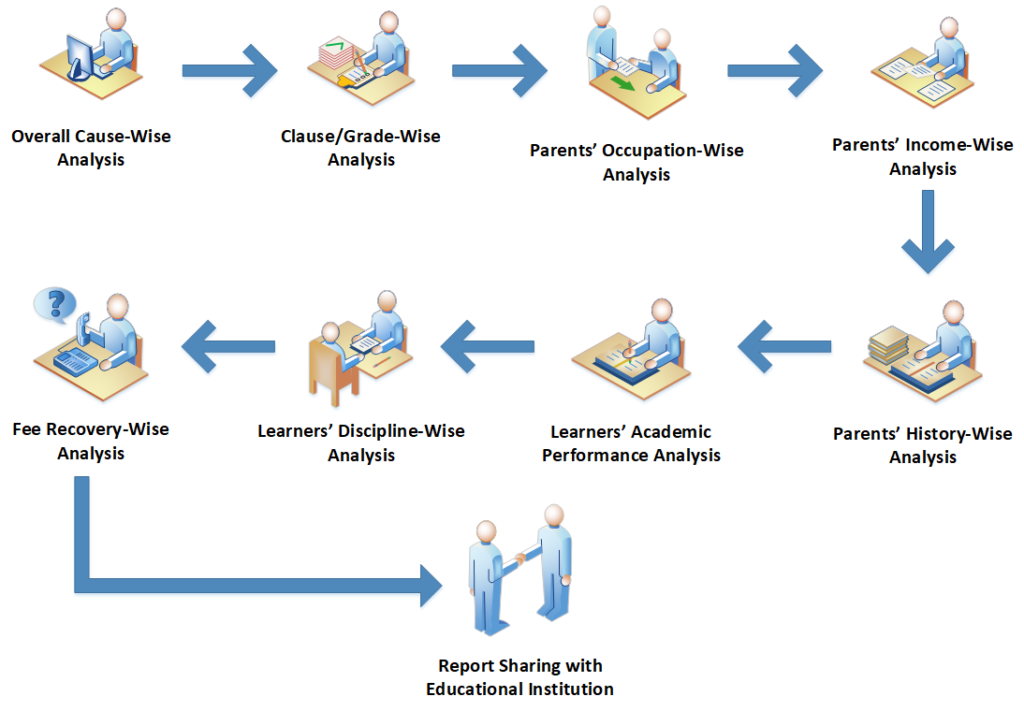Educational Diagnostic Analysis - EDA
Diagnostic analysis is a series of new educational services to identify and prioritize the potential causes of certain problems supported by historical data of an educational institution. More specifically, in diagnostic analysis, we look at historical data statistically to tell the educational institution what happened in the past and then will take further step by providing deeper analysis to answer the question:
“Why did this happen?”
Diagnostic analysis can be termed as root cause analysis (RCA). During diagnostic analytics we explore the data and brainstorm all possible reasons/causes which can contribute to the problem e.g. late submission of educational institution fees by parents. Finally, we use a variety of quality tools to drill down the data to find out the most specific reason/s of the problem that is “late fees submission”.
Purpose of Diagnostic Analysis
It is widely recognized that educational institutions, colleges and universities play a vital role in the development of societies across the globe. For instance, educational institutions provide leaners with a quality education that enables them to acquire knowledge and learn new skills e.g., reading and writing to become a useful citizens of society.
Rationale for Selecting the Problem “Late Fee Submission”
The effectiveness of leaners’ learning is dependent on provision of quality teaching and learning as well as other support services. While, on the other hand all educational institution systems, operations, processes and educational services are dependent on leaners’ fees. Financially stable educational institutions tend to provide quality education to their leaners in an efficient and effective way as compared to educational institutions which are financially weak.
Hence, the main purpose of the diagnostic analysis is to facilitate educational institutions in collecting specific and relevant data of at least six months and then apply certain quality tools to analyze the data statistically. This will enable educational institutions to know the potential causes of late fee submission by leaners’ parents and then based on diagnostic analysis to find a most specific reasons/causes which are adversely affecting the timely submission of educational institution fees. Subsequently, the diagnosis will support to data driven decision making for the educational institutions.
Process of Conducting a Diagnostic Analysis

Define The Problem
The first step in the problem solving and decision making process is to identify and define the problem. A problem can be regarded as a difference between the actual situation and the desired situation. “A problem well stated is a problem half solved” is a common phrase in the problem-solving field attributed to former GM executive Charles Kettering (Willingham 1999, 162). That is, rather than jumping to conclusions, if we take the time to ensure that we have a clear understanding of what the problem really is (or isn’t), it will save a lot of time further on that might have been wasted. For instance, do you think that it is problem?
“Actual Situation” Vs “Desired Situation”
70% Fees Collection Vs 100% Fees Collection
Once the specific problem to work on has been identified, a clear, concise, and complete problem statement should be developed. A good problem definition can help make the diagnosis more focused and productive. The components of a good problem statement should include the following:
What: A description of what happened (that shouldn’t have) or didn’t happen (that should have), or what happened that the organization would like to see happen again, or simply what change in performance is desired.
Where: Where specifically the problem was found. Note that this could be geographic, and/or where in the process, and/or location on the product.
Who: If the problem directly affects an individual or group of people, “who” often becomes an expansion of, or replacement for, “where.”
When: When the problem was first found and/or when it began (if known).
How much: The frequency and/or magnitude of the problem. Numbers provided should be absolute values (plus percentages if useful for normalizing the data).
Outcome
Problem Statement of “Late Fees Submission”
“10% of leaners’ parents at ABC Educational institution are not submitting the tuition fee (Educational institution Fees) in accounts department for last six months”.
— OR —
“30% of leaners’ parents at ABC Educational institution are submitting the tuition fee (Educational institution Fees) late (i.e., after deadline) in accounts department for last six months”.
How we do it?
The activities that we make up in this process are not random or ad hoc; they are related and organized. All the activities in the process work together toward a common goal. Processes exist to achieve results valued by internal and external customers. We follow ISO standards that defines the process as “set of interrelated or interacting activities which transforms inputs into outputs”.



